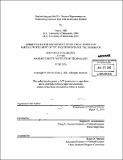| dc.contributor.advisor | Stephen D. Ansolabehere. | en_US |
| dc.contributor.author | Hill, Tony L. | en_US |
| dc.contributor.other | Massachusetts Institute of Technology. Dept. of Political Science. | en_US |
| dc.date.accessioned | 2010-10-29T18:41:50Z | |
| dc.date.available | 2010-10-29T18:41:50Z | |
| dc.date.copyright | 2010 | en_US |
| dc.date.issued | 2010 | en_US |
| dc.identifier.uri | http://hdl.handle.net/1721.1/59794 | |
| dc.description | Thesis (Ph. D.)--Massachusetts Institute of Technology, Dept. of Political Science, 2010. | en_US |
| dc.description | Cataloged from PDF version of thesis. | en_US |
| dc.description | Includes bibliographical references (p. 153-171). | en_US |
| dc.description.abstract | This dissertation analyzes the effects of Congressional redistricting in the United States using the Brookes Method, developed by R.H. Brookes, a New Zealand political scientist. The Brookes Method disaggregates electoral bias into five separate components. My analysis shows that the party winning control of the House benefits from the most prevalent component of bias but that Democrats persistently benefit from the next most prevalent component. This means that Republicans can never win the House as effectively as Democrats can. The Brookes Method also informs electoral bias pertaining to racial gerrymandering. Using the Brookes Method to evaluate three states with a history of using extremes in race-based redistricting (Georgia, Louisiana, and North Carolina), my analysis reveals that these states have disaffected Democrats in redistricting more sharply than has the country as a whole. Using the Brookes Method to evaluate the small number of states using independent commissions to carry out Congressional redistricting, I find that electoral bias in these states is different from that found in states with legislative redistricting, and surprisingly, is often higher in commission states. This suggests that commissions are in some cases not truly independent and/or are merely fomenting a different kind of partisanship. I propose a new formulation (the Hill Ratio) of a familiar compactness standard, the area-perimeter measure. Thousands of House districts across time are analyzed under the measure and trends in compactness are noted. My analysis finds that districts in the U.S. have gotten considerably less compact since the early 20th century, while districts in Canada are still more compact than U.S. districts were even in the 1920s. Some of the states noted for their noncompact districts in the 2000s also had the least compact districts in the early 20th century. Finally, compactness is used as a factor in voter knowledge. My analysis finds that voters in non-compact districts are less likely to possess basic knowledge about their representatives and districts than voters in compact districts, while knowledge about statewide and national officeholders and party control is largely unaffected by the compactness of the congressional district. This is true when analyzed both at the aggregate and the individual level. These two measures of districting are harmonious with proportional representation ideals. The Brookes Method is an explicit comparison of majoritarian seat outputs with a proportional ideal. Compactness, in the words of Polsby & Popper, "tends to inhibit gerrymandering. By inhibiting gerrymandering, in turn, one abets proportional representation ... by empirical tendency." | en_US |
| dc.description.statementofresponsibility | by Tony L. Hill. | en_US |
| dc.format.extent | 171, [9] p. | en_US |
| dc.language.iso | eng | en_US |
| dc.publisher | Massachusetts Institute of Technology | en_US |
| dc.rights | M.I.T. theses are protected by
copyright. They may be viewed from this source for any purpose, but
reproduction or distribution in any format is prohibited without written
permission. See provided URL for inquiries about permission. | en_US |
| dc.rights.uri | http://dspace.mit.edu/handle/1721.1/7582 | en_US |
| dc.subject | Political Science. | en_US |
| dc.title | Redistricting and the U.S. House of Representatives : illuminating electoral bias with the Brookes Method | en_US |
| dc.title.alternative | Redistricting and the US House of Representatives : illuminating electoral bias with the Brookes Method | en_US |
| dc.title.alternative | Redistricting and the United States House of Representatives : illuminating electoral bias with the Brookes Method | en_US |
| dc.type | Thesis | en_US |
| dc.description.degree | Ph.D. | en_US |
| dc.contributor.department | Massachusetts Institute of Technology. Department of Political Science | |
| dc.identifier.oclc | 671485957 | en_US |
